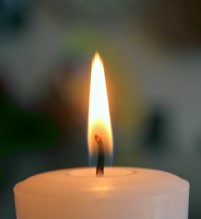By premixing the gas with air.
When gas is allowed to escape into the air through a tube and then set alight, it burns with a yellow flame, called a luminous flame. It is luminous and yellow because it produces carbon soot that is heated until it glows yellow.
The presence of unburned carbon soot is an indication that the gas is not burning completely, and some of the energy available in the gas is wasted. The gas is not mixing well with the air before it burns.
If we mix some air with the gas before it reaches the flame, then more of the gas will be able to burn, and the result will be a hotter flame, without any soot. Hotter flames burn blue instead of yellow, and are not as bright, because there is no soot to heat to incandescence.
To mix air with the gas before it reaches the flame, a gas stove has a small opening for the gas, to make it jet out quickly into the air. It also has holes in the tube so the jet of unburned gas can draw in air through what is called the Venturi effect. The air and the gas mix thoroughly in the tube as the mixture travels to the openings in the burner. The openings are small holes, so that the flame does not travel back down into the tube. You can see the flames are blue, and have little or no soot, and they start a little bit away from the holes in the burner.
Other gas heating devices work the same way. If you have a gas heater in your house, it premixes the air before igniting it. A gas clothes dryer also does this. In a chemist’s laboratory, the Bunsen burner also has a small gas jet that sucks up air from holes in the tube and mixes the air and gas before burning it at the far end of the tube.
To get the hottest flames, a large amount of air is used, so that all of the gas burns. To allow this to happen without igniting the gas and air too early, in the wrong place, a screen of metal can be used to separate the flame from the gas and air mixture. The flame cannot get past the screen, since the metal draws off too much of the heat. A burner with this design is called a Meker burner, and this concept is also used in gas stoves for the kitchen, where the tiny exit holes act as the screen.
